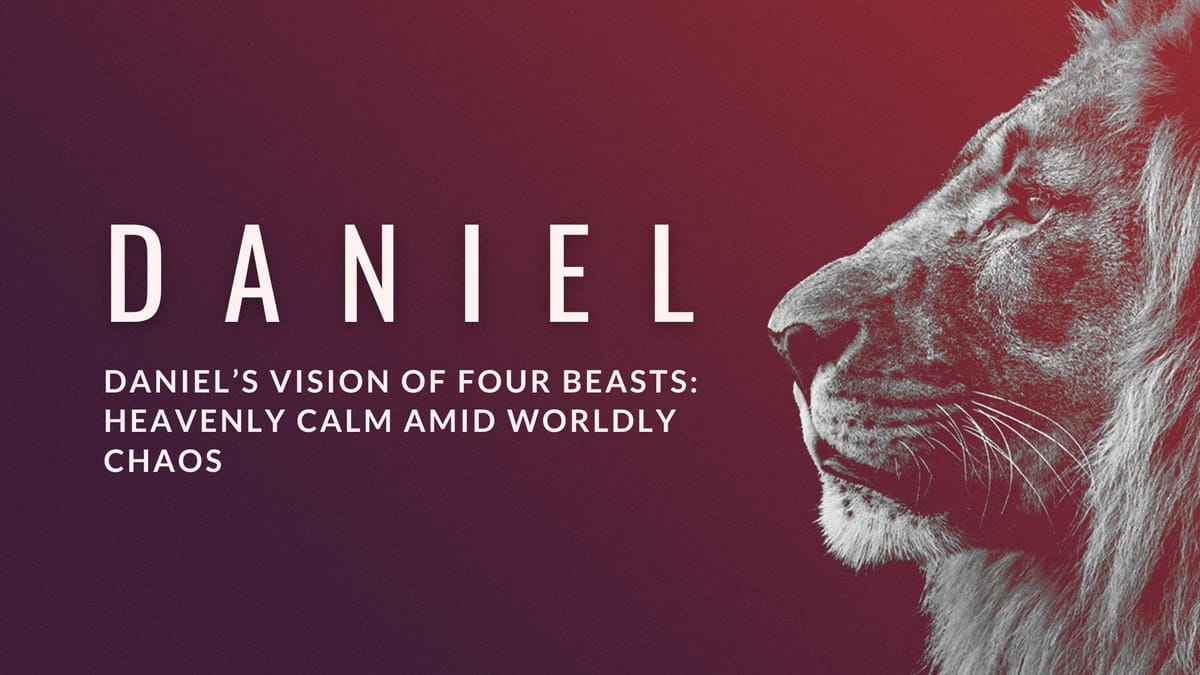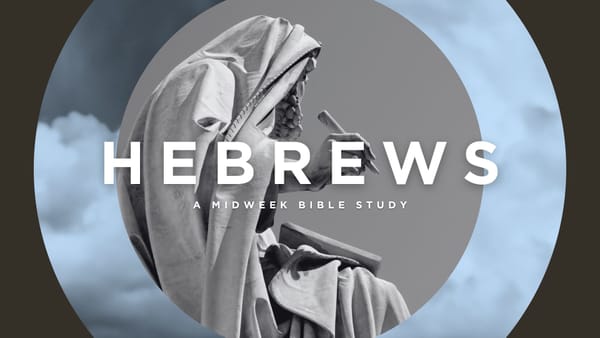Sermon Summary: Daniel's Vision of Four Beasts: Heavenly Calm Amid Worldly Chaos (Daniel 7)
While the world may feel chaotic, we rest in the knowledge that God is on His throne, and Christ is coming again.

Summary
Daniel 7 transitions from historical narratives to apocalyptic visions, unveiling God's sovereign plan through vivid and symbolic imagery. Daniel's vision of four beasts rising from chaotic seas portrays earthly kingdoms as tumultuous and transient, but the Ancient of Days and the Son of Man offer a vision of heavenly calm and eternal reign. This chapter assures us that while the world may seem chaotic, God is in control, and His eternal kingdom will prevail. As believers, we are called to live with peace, serve faithfully, and reflect the hope of Christ's unshakable reign.
Big Idea
God can give us heavenly calm in a chaotic world.
Introduction
Daniel 7 takes us back in time to the first year of Belshazzar's reign, predating the events of the lions' den and Babylon's fall. This chapter marks a turning point in the book, shifting from the historical narratives we've explored over the past weeks to apocalyptic literature—a genre that is both fascinating and challenging.
The word "apocalypse" might unsettle some, conjuring images of doom or end-of-the-world catastrophes. Yet, in Scripture, apocalyptic literature means something far broader and more hopeful: God pulling back the curtain to reveal heavenly realities, many about the future. Its vivid imagery and symbolic language can feel intimidating—so much so that some shy away from these chapters. But we must remember: this is still God’s inspired Word, profitable for teaching, correction, and equipping us for every good work (2 Timothy 3:16-17).
As we approach this passage, we do so with humility. Scripture holds clear, essential truths we embrace with full confidence. Yet some elements—like the symbolic visions of Daniel 7—invite a posture of grace and teachability, reminding us that finite creatures cannot fully grasp the infinite God. With this in mind, let us step into Daniel’s extraordinary vision. Doing so, we'll see how God can give us heavenly calm in a chaotic world.
The Vision: Beasts Rising from Chaos
In his vision, Daniel sees four beasts rise out of the sea, which is churned by the winds of heaven. The sea, often a biblical metaphor for chaos and unrest, represents the turbulent world we inhabit—a world where deeper spiritual forces are at play behind the rise and fall of nations. What appears to be random turmoil is not merely under God’s control but part of His sovereign and ordained plan, unfolding according to His eternal purposes, even when human events seem chaotic.
This vision echoes Nebuchadnezzar’s dream in Daniel 2, which depicted a grand statue representing successive earthly kingdoms. However, while Nebuchadnezzar’s statue highlighted the splendor of these empires from a human perspective, Daniel’s vision reveals their true nature as chaotic, destructive beasts. The contrast reminds us that God sees things differently than we do—what may seem powerful and glorious to us often masks disorder and rebellion against Him.
Nebuchadnezzar’s dream was a message to the non-believing world, emphasizing the inevitable collapse of human power and the establishment of God’s eternal kingdom. By contrast, Daniel’s vision was given to encourage God’s people, reminding them that even under oppressive regimes, God’s sovereign plan is advancing, and His eternal kingdom will ultimately prevail.
The Beasts: A Portrait of Earthly Kingdoms
The First Beast: Babylon
The first beast, a lion with eagle’s wings, represents Babylon and its king, Nebuchadnezzar. The lion, a symbol of strength and majesty, combined with the eagle’s swiftness, reflects Babylon’s dominance and rapid expansion under Nebuchadnezzar. But Daniel observes the wings being plucked off, likely referring to Nebuchadnezzar’s humbling in Daniel 4, when God caused him to lose his sanity and live like an animal. Yet God, in His mercy, restored him. The lion standing on two feet like a man, with a human mind, symbolizes Nebuchadnezzar’s transformation into a humbled king who acknowledged God’s sovereignty.
The Second Beast: Medo-Persia
The second beast, a bear raised on one side with three ribs in its mouth, represents the Medo-Persian Empire. The uneven posture reflects the dominance of Persia over Media within their alliance. The three ribs likely symbolize Medo-Persia’s significant conquests—Babylon, Lydia, and Egypt. The bear, slower but more powerful than the lion, portrays the empire’s relentless expansion through sheer force.
The Third Beast: Greece
The third beast, a leopard with four wings and four heads, represents the Greek Empire under Alexander the Great. The leopard’s natural speed and ferocity, enhanced by wings, capture the unparalleled swiftness of Alexander’s conquests, which spanned from Greece to India in just a few years. However, Alexander’s untimely death led to his empire’s division among four generals—symbolized by the four heads. Though fragmented, Greek cultural influence endured, shaping the world for centuries.
The Fourth Beast: Rome and Beyond
The fourth beast is different—terrifying, dreadful, and exceedingly strong, with iron teeth and ten horns. It crushes and tramples everything in its path, symbolizing the Roman Empire’s unmatched power and domination. The ten horns represent future rulers, and the emergence of a “little horn” hints at a ruler who will lead a global rebellion against God. This points to the Antichrist, a figure of ultimate opposition to God and His people. Daniel’s vision extends beyond Rome, offering a glimpse of a future world empire culminating in unparalleled persecution and defiance of God.
The Ancient of Days and the Son of Man: A Vision of Heavenly Calm
Amid the chaos, Daniel’s vision shifts to the throne room of heaven. In verse 9, the Ancient of Days—God Himself—takes His seat in judgment. His garments are as white as snow, and His throne is ablaze with fire. This is the sovereign Judge of all creation, whose authority will bring every corrupt kingdom to an end. The imagery reminds us that while earthly kingdoms rage, God remains firmly on His throne, unshaken and unchallenged.
Then, in verse 13, we see the Son of Man—Jesus Christ—coming with the clouds of heaven. He approaches the Ancient of Days and receives authority, glory, and sovereign power. All nations will worship Him, and His eternal kingdom will never be destroyed. Jesus is that stone, the King of kings whose reign was inaugurated through His victory on the cross and His resurrection, and whose kingdom will endure forever, bringing redemption and restoration to all creation.
Living with Heavenly Calm Amid Worldly Chaos
What does Daniel’s vision mean for us today? Let’s consider three implications that help us live with peace and purpose in the midst of a turbulent world.
First, we can experience heavenly peace in a turbulent world.
The vision of the Ancient of Days and the Son of Man reminds us that no matter how chaotic or unstable the world appears, God’s throne is secure, and His purposes are unshaken. Like Daniel, who lived under the rise and fall of empires, we too witness constant change—political shifts, economic uncertainty, and social upheaval. Yet the calm of heaven is not just a future reality; it is ours now through union with Christ, as the Spirit applies His peace to our hearts, grounding us in His promises and presence. For this reason, Jesus said, "Peace I leave with you; my peace I give you. I do not give to you as the world gives. Do not let your hearts be troubled and do not be afraid" (John 14:27).
This heavenly peace doesn’t depend on circumstances but on the unchanging character of God. When we anchor our hearts in His promises, we can face life’s storms with confidence, knowing that the God who rules over history also holds our future. As Paul writes, “Do not be anxious about anything… And the peace of God, which surpasses all understanding, will guard your hearts and your minds in Christ Jesus” (Philippians 4:6-7).
Second, this heavenly-minded calm helps us perform earthly good.
Far from withdrawing from the world, our confidence in God’s eternal kingdom empowers us to engage deeply with the world around us. Like Daniel, who served faithfully in Babylon, we are called to invest in our work, communities, and relationships—not as reluctant participants but as purposeful agents of God’s glory. Daniel knew Babylon wasn’t his ultimate home, yet he worked with diligence and integrity, influencing the very heart of a pagan empire. Similarly, as citizens of heaven (Philippians 3:20), we understand that earthly kingdoms will pass away, but this perspective frees us to work for the common good without placing ultimate hope in temporary systems. Whether through our jobs, volunteer efforts, or everyday interactions, a world in constant change desperately needs steadfast servants who reflect the unchanging love and truth of God.
Finally, we can serve earthly kings and kingdoms as a faithful expression of our service to God.
Just as Daniel served Babylonian and Persian rulers with integrity and excellence, we too are called to represent God in our spheres of influence. Whether in government, business, education, or another field, our work ultimately points to the King of kings. Colossians 3:23-24 reminds us, “Whatever you do, work heartily, as for the Lord and not for men, knowing that from the Lord you will receive the inheritance as your reward. You are serving the Lord Christ.” This perspective transforms even mundane tasks into acts of worship and witness. When we labor with faithfulness, honesty, and love, we reflect God’s character to those around us, creating opportunities to share the hope we have in Christ. Our earthly service becomes a testimony to God’s eternal reign, reminding others that every good gift flows from Him.
Conclusion
Daniel 7 offers a stunning vision of the future, reminding us that while the world may seem chaotic, God is in control, and His kingdom will endure forever. As we rest in this truth, let us live with heavenly calm amid worldly chaos, serving faithfully and pointing others to the hope we have in Christ.
Amen.




